Sistine Chapel
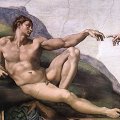 The Sistine Chapel (Cappella Sistina) is a chapel in
the Apostolic Palace, the official residence of the Pope, in the
Vatican City. Its fame rests on its architecture, which evokes the
Temple of the Old Testament, its decoration, frescoed throughout by
the greatest Renaissance artists, including Michelangelo, whose
ceiling is legendary, and its purpose, as a site of papal religious
and functionary activity, notably the conclave, at which a new Pope is
selected.
The Sistine Chapel (Cappella Sistina) is a chapel in
the Apostolic Palace, the official residence of the Pope, in the
Vatican City. Its fame rests on its architecture, which evokes the
Temple of the Old Testament, its decoration, frescoed throughout by
the greatest Renaissance artists, including Michelangelo, whose
ceiling is legendary, and its purpose, as a site of papal religious
and functionary activity, notably the conclave, at which a new Pope is
selected.
Michelangelo's painting
"It has been said (but I think this is just a story) that Michelangelo Buonarroti nailed some poor man to a board and pierced his heart with a spear, so as to paint a Crucifixion." - Francesco Susinno.
Michelangelo was commissioned by Pope Julius II in 1508 to repaint the ceiling, originally representing golden stars on a blue sky; the work was completed between 1508 and 1 November 1512. He painted the Last Judgment over the altar, between 1535 and 1541, being commissioned by Pope Paul III Farnese. Michelangelo felt that he was a more developed sculptor than a painter, but he accepted the offer.
Michelangelo used bright colors, easily visible from the floor. On the lowest part of the ceiling he painted the ancestors of Christ. Above this he alternated male and female prophets, with Jonah over the altar. On the highest section Michelangelo painted nine stories from the Book of Genesis.
Michelangelo was originally commissioned to paint only 12 figures, the Apostles. He turned down the commission because he saw himself as a sculptor, not a painter. The Pope offered to allow Michelangelo to paint biblical scenes of his own choice as a compromise. When the work was finished there were more than 300. His figures showed the creation, Adam and Eve in the Garden of Eden and the Great Flood. Michelangelo used male models, even for the females, because female models were rare and more expensive.
Among the many poems written by Michelangelo there is one describing the experience of spending many long hours painting the ceiling, the strain of bending bacward with his arms raised and the paint dripping onto his face. He was left with neck and back problems the for rest of his life. Contrary to popular belief he painted in a standing position, not lying on his back.
Sistine Chapel ceiling
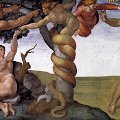 The
subject matter of the ceiling is the doctrine of Humankind's need for
Salvation as offered by God in Jesus through the Church. In other
words, the ceiling illustrates that God made the World as a perfect
creation and put Humankind into it, Humankind fell into disgrace and
was punished by death, and by separation from God. God sent Prophets
and Sybils to tell Humankind that the Saviour or Christ, Jesus, would
would bring them redemption. God prepared a lineage of people, all the
way from Adam, through various characters written of in the Old
Testament, such as King David, to the Virgin Mary through whom the
Saviour of Humankind, Jesus, would come. The various components of the
ceiling are linked to this doctrine.
The
subject matter of the ceiling is the doctrine of Humankind's need for
Salvation as offered by God in Jesus through the Church. In other
words, the ceiling illustrates that God made the World as a perfect
creation and put Humankind into it, Humankind fell into disgrace and
was punished by death, and by separation from God. God sent Prophets
and Sybils to tell Humankind that the Saviour or Christ, Jesus, would
would bring them redemption. God prepared a lineage of people, all the
way from Adam, through various characters written of in the Old
Testament, such as King David, to the Virgin Mary through whom the
Saviour of Humankind, Jesus, would come. The various components of the
ceiling are linked to this doctrine.
The Sistine Chapel had great symbolic meaning for the papacy as the chief consecrated space in the Vatican, used for great ceremonies such as electing and inaugurating new popes. It already contained distinguished wall paintings, and Michelangelo was asked to add works for the relatively unimportant ceiling. Twelve Apostles were planned as the theme - ceilings normally showed only individual figures, not dramatic scenes. Traces of this project are seen in the 12 large figures that Michelangelo produced: seven prophets and five sibyls, or female prophets found in classical myths. The inclusion of female figures was very unusual though not totally unprecedented.
Michelangelo placed these figures around the edges of the ceiling and filled the central spine of the long curved surface with nine scenes from Genesis: three of them depicting the creation of the world, three the stories of Adam and Eve, and three the stories of Noah. These are naturally followed, below the prophets and sibyls, by small figures of the 40 generations of Christ's ancestors, starting with Abraham. The vast project was completed in less than four years; there was an interruption perhaps of a year in 1510-11 when no payment was made.
The work began at the end, with the Noah scenes placed over the entrance door, and moved toward the altar in the direction opposite to that of the sequence of the stories. The first figures and scenes naturally show the artist reusing devices from his earlier works, such as the Pieta, since he was starting on such an ambitious work in an unfamiliar medium. These first figures are relatively stable, and the scenes are on a relatively small scale. As he proceeded, he quickly grew in confidence.
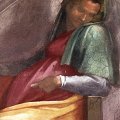 Indeed, recent investigations of the technical processes used
show that he worked more and more rapidly, reducing and finally
eliminating such preparatory helps as complete drawings and incisions
on the plaster surface. The same growing boldness appears in the free,
complex movements of the figures and in their complex expressiveness.
While remaining always imposing and monumental, they are more and more
imbued with suggestions of stress and grief. This may be perceived in
a figure such as the prophet Ezekiel halfway along. This figure
combines colossal strength and weight with movement and facial
expression that suggest determination to reach a goal that is
uncertain of success. Such an image of the inadequacy of even great
power is a presentation of heroic and tragic humanity and is central
to what Michelangelo means to posterity.
Indeed, recent investigations of the technical processes used
show that he worked more and more rapidly, reducing and finally
eliminating such preparatory helps as complete drawings and incisions
on the plaster surface. The same growing boldness appears in the free,
complex movements of the figures and in their complex expressiveness.
While remaining always imposing and monumental, they are more and more
imbued with suggestions of stress and grief. This may be perceived in
a figure such as the prophet Ezekiel halfway along. This figure
combines colossal strength and weight with movement and facial
expression that suggest determination to reach a goal that is
uncertain of success. Such an image of the inadequacy of even great
power is a presentation of heroic and tragic humanity and is central
to what Michelangelo means to posterity.
Nearby the scene of the creation of Eve shows her with God and Adam, compressed within too small a space for their grandeur. This tension has been interpreted as a token of a movement away from the Renaissance concern with harmony, pointing the way for a younger generation of artists like Pontormo, often labeled Mannerists. Michelangelo's work on the ceiling was interrupted, perhaps just after these figures were completed. When he painted the second half, he seemed to repeat the same evolution from quiet stability to intricacy and stress. Thus he worked his way from the quietly monumental and harmonious scene of the creation of Adam to the acute, twisted pressures of the prophet Jonah. Yet in this second phase he shows greater inward expressiveness, giving a more meditative restraint to the earlier pure physical mass.
The Last Judgement
In 1534 Michelangelo returned after a quarter century to fresco painting, executing for the new pope, Paul III, the huge "Last Judgment" for the end wall of the Sistine Chapel. This theme had been a favoured one for large end walls of churches in Italy in the Middle Ages and up to about 1500, but thereafter it had gone out of fashion. It is often suggested that this renewal of a devout tradition came from the same impulses that were then leading to the Counter-Reformation under the aegis of Paul III. The work is in a painting style noticeably different from that of 25 years earlier. The pervasive colour harmony is a simple one of brown bodies against dark blue sky.
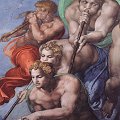 The
figures have less energy and their forms are less articulate, the
torsos tending to be single fleshy masses without waistlines. At the
top centre Christ as judge lifts an arm to save those on his right and
drops the other arm to damn those on his left, suggesting in the idiom
of the period a scale to weigh men in the balance. The saved souls
rise slowly through the heavy air, as the damned ones sink. At the
bottom of the wall skeletons rise from tombs, a motif taken directly
from medieval precedents. To the right Charon ferries souls across the
River Styx, a pagan motif which Dante had made acceptable to
Christians in his Divine Comedy and which had been introduced into
painting about 1500 by the Umbrian artist Signorelli. Michelangelo
admired this artist for his skill in expressing dramatic feeling
through anatomical exactitude.
The
figures have less energy and their forms are less articulate, the
torsos tending to be single fleshy masses without waistlines. At the
top centre Christ as judge lifts an arm to save those on his right and
drops the other arm to damn those on his left, suggesting in the idiom
of the period a scale to weigh men in the balance. The saved souls
rise slowly through the heavy air, as the damned ones sink. At the
bottom of the wall skeletons rise from tombs, a motif taken directly
from medieval precedents. To the right Charon ferries souls across the
River Styx, a pagan motif which Dante had made acceptable to
Christians in his Divine Comedy and which had been introduced into
painting about 1500 by the Umbrian artist Signorelli. Michelangelo
admired this artist for his skill in expressing dramatic feeling
through anatomical exactitude.
In the end
Extremely jealous of his work, he refused to show it to anyone but the pope, though the latter was always insisting that he finish it quickly, and often climbed the scaffolding to see how the fresco was proceeding. The pressure on the artist was such that he uncovered it in August 1511, even before it was finished. The sight of these highly original paintings made a great impression on the artists of the time. Raphael, who was painting the nearby Stanze, was so influenced by them that his own style altered as a result, becoming more plastic and sculptural as the decoration proceeded.
The project was physically and emotionally torturous for Michelangelo. Michelangelo recounts its effect on him with these words: "After four tortured years, more than 400 over life-sized figures, I felt as old and as weary as Jeremiah. I was only 37, yet friends did not recognize the old man I had become."
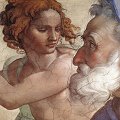 Working high above the chapel floor, on scaffolding,
Michelangelo painted, between 1508 and 1512, some of the finest
pictorial images of all time. On the vault of the papal chapel, he
devised an intricate system of decoration that included nine scenes
from the Book of Genesis, beginning with God Separating Light from
Darkness and including the Creation of Adam and Eve, the Temptation
and Fall of Adam and Eve, and the Flood. These centrally located
narratives are surrounded by alternating images of prophets and sibyls
(Libyan, Erythraean) on marble thrones, by other Old Testament
subjects, and by the ancestors of Christ. In order to prepare for this
enormous work, Michelangelo drew numerous figure studies and cartoons,
devising scores of figure types and poses. These awesome, mighty
images, demonstrating Michelangelo's masterly understanding of human
anatomy and movement, changed the course of painting in the West.
Working high above the chapel floor, on scaffolding,
Michelangelo painted, between 1508 and 1512, some of the finest
pictorial images of all time. On the vault of the papal chapel, he
devised an intricate system of decoration that included nine scenes
from the Book of Genesis, beginning with God Separating Light from
Darkness and including the Creation of Adam and Eve, the Temptation
and Fall of Adam and Eve, and the Flood. These centrally located
narratives are surrounded by alternating images of prophets and sibyls
(Libyan, Erythraean) on marble thrones, by other Old Testament
subjects, and by the ancestors of Christ. In order to prepare for this
enormous work, Michelangelo drew numerous figure studies and cartoons,
devising scores of figure types and poses. These awesome, mighty
images, demonstrating Michelangelo's masterly understanding of human
anatomy and movement, changed the course of painting in the West.
Quotes
Giorgio Vasari:
-
This work has been and truly is a beacon of our art, and it has
brought such benefit and enlightenment to the art of painting that it
was sufficient to illuminate a world which for so many hundreds of
years had remained in the state of darkness. And, to tell the truth,
anyone who is a painter no longer needs to concern himself about
seeing innovations and inventions, new ways of painting poses,
clothing on figures, and various awe-inspiring details, for
Michelangelo gave to this work all the perfection that can be given to
such details.
Goethe:
-
Without having seen the Sistine Chapel one can form no appreciable
idea of what one man is capable of achieving.
Werner Herzog:
-
Many years ago I went to the Vatican and looked at Michelangelo's
frescoes in the Sistine Chapel. I was overwhelmed with the feeling
that before Michelangelo no one had ever articulated and depicted
human pathos as he did in those paintings. Since then all of us have
understood ourselves just that little bit deeper, and for this reason
I truly feel his achievements are as great as the invention of
agriculture.
Michelangelo Art

|
|
More
Articles
 Art Encyclopedia A world history of art in articles.
Art Encyclopedia A world history of art in articles.
Renaissance
Michelangelo
Art, life and biography.
Michelangelo's David.
Michelangelo's Pieta.
Sistine Chapel. High Renaissance Masterpiece.
Sistine Chapel. Book of Genesis.
Sistine Chapel. The Ignudi.
Sistine Chapel. Seven Prophets.
Sistine Chapel. Five Sibyls.
Sistine Chapel. Lunettes.
Sistine Chapel. Pendentives.
Sistine Chapel. The Ancestors of Christ.
Sistine Chapel. The Last Judgement.
Art
 Art Wallpapers Art image collections for your desktop.
Art Wallpapers Art image collections for your desktop.
Della Francesca Art, $19
(95 pictures)
Da Vinci Art, $25
(80 pictures)
Michelangelo Art, $29
(180 pictures)
Raphael Art, $25
(125 pictures)
Titian Art, $29
(175 pictures)
Durer Art, $25
(120 pictures)

